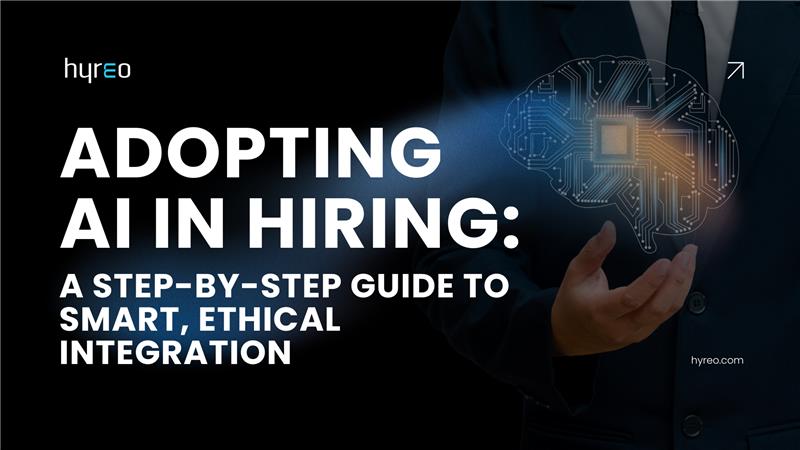You don’t hire everyone who applies for the job you posted, do you? Then, why not leverage AI technology instead of wasting your time, energy, and money on screening a large volume of candidates?
Think about it. High-volume hiring typically involves an avalanche of applications and multiple open positions. On top of this, you have to make sure you deliver in terms of candidate experience and fairness to all candidates. Manually doing all the processing and redundant admin activities would drain you, but it won’t necessarily get you closer to the right candidates.
In fact, the right candidate might get missed in the pile when you have less time, leading to skimming and screening only profiles from the top. With prescreening driven by AI, things can be different.
In this blog, we’ll explore how AI prescreening works and how it brings better hiring outcomes during high-volume hiring.
What is AI prescreening in high-volume hiring?
AI prescreening involves using artificial intelligence to automate the initial stages of the recruitment process, such as resume screening and candidate ranking. In high-volume hiring, where companies receive hundreds or even thousands of applications for a single role, AI tools help quickly identify the most qualified candidates, reducing the time and effort required by human recruiters. This automation allows HR teams to focus on more strategic tasks, such as interviews and decision-making.
Watch our podcast: Hyreo Rise with Steve Hunt on ‘Quality of Hire’
Top 5 Advantages of AI-Driven Prescreening
The initial phase of high-volume hiring, which usually involves resume parsing and candidate screening, can take a lot of time if done manually, leading to dreaded recruiter burnout. But with technology-assisted processes, it can be quick and efficient, leaving more room and time for recruiters. We’ve listed some of the advantages of using AI in your prescreening process. Check it out and see how it would work if you integrated AI prescreening into your hiring workflows.

- Improves hiring efficiency
AI prescreening automates the initial stages of candidate evaluation. It enhances efficiency by automating repetitive tasks like resume parsing, keyword matching, and initial candidate assessments. For instance, AI tools can process thousands of candidates in a fraction of the time it would take human recruiters, significantly reducing the time spent on manual screening. This acceleration leads to faster time-to-hire, allowing companies to fill positions more quickly and maintain productivity. More importantly, it ensures all applications are covered, and the top applicants get through. On the bright side, this efficiency allows HR teams to focus on more strategic aspects of recruitment, such as interviews and decision-making.
- Reduces bias in candidate selection
Yes, when properly implemented, AI prescreening can help reduce unconscious bias by focusing on objective criteria such as skills, experience, and qualifications. AI keeps job descriptions, assessment questions, etc. bias-free and thus strengthens diversity and inclusion in prescreening.
According to a research article by Educational Administration: Theory and Practice, Unilever used AI for sourcing and prescreening, leading to the elimination of bias and an increase in talent diversity by 16%.
However, it’s crucial to ensure that the AI models are trained on diverse and representative data to avoid perpetuating existing biases. Regular audits and updates to the AI systems are necessary to maintain fairness and equity in the hiring process.
Also read: Reducing Hiring Bias with Automation & AI
- Significant cost savings for hiring
Implementing AI prescreening can lead to significant cost savings by automating time-consuming tasks, reducing the need for extensive manual labor, and decreasing time-to-hire. For example, according to LinkedIn, companies have reported a 30% reduction in recruitment costs after integrating AI tools into their hiring processes. These savings can be reinvested into other areas of the business, enhancing overall organizational efficiency.
According to HireGenix’s whitepaper on the ROI of modern recruitment tech, companies implementing AI-powered solutions for recruitment tasks, including screening, see a 37% decrease in cost-per-hire and a 3.2x ROI within the first year of implementation.
Also read: Optimizing Recruiting Costs: Key Drivers and Strategies
- Enhances candidate experience
AI prescreening improves the candidate experience by providing timely updates, faster responses, personalized interactions, and consistent & transparent communication. Applicants receive timely updates on their application status, reducing uncertainty. AI-powered chatbots can answer candidate queries, provide screening guidance and feedback, ensuring that candidates feel valued and informed. This positive experience can enhance the company’s employer brand and attract top talent.
According to Aptitude Research, companies introducing conversational AI into the hiring process are 3 times more likely to improve the candidate experience.
Product Video: Hyreo Candidate Experience CX management tool to enhance your Employer Brand
- Accurate evaluation
AI prescreening tools are generally highly accurate at matching candidates to job requirements based on structured data such as skills, experience, and education. Advanced natural language processing (NLP) algorithms can analyze resumes, LinkedIn profiles, and application answers to rank candidates objectively. Accuracy improves when AI is trained on high-quality, diverse datasets and regularly validated against hiring outcomes. Bottom line: it’ll get you the best candidates — academically, culturally, and professionally fit for your organization as well as the role you’re hiring for.
Challenges of AI Prescreening
Implementing AI prescreening comes with challenges such as data privacy, integration with existing systems, and potential biases in AI algorithms. Organizations must ensure compliance with GDPR and other regulations to protect candidate data. Integration with applicant tracking systems (ATS) and HR software can be complex, requiring IT support. AI models must be trained on unbiased, representative datasets to avoid discriminatory outcomes.
Also read: Tips & Methods to stay ahead with Pre-employment Screening
Conclusion
AI prescreening offers significant advantages in high-volume hiring, including increased efficiency, cost savings, and improved candidate experience. However, it’s essential to address challenges such as potential biases and ethical considerations to ensure fair and effective recruitment processes. By implementing best practices and continuously monitoring AI systems, organizations can harness the full potential of AI in hiring.
Interested in enhancing your recruitment process with AI prescreening? Contact us today to learn how our solutions can streamline your hiring and improve candidate outcomes.
FAQs
- How does AI prescreening save time in high-volume hiring?
AI prescreening automates resume parsing and candidate ranking, cutting screening time from weeks to hours. This helps recruiters focus on interviews and decision-making. - Can AI prescreening reduce hiring bias?
Yes. When trained on diverse data, AI evaluates candidates based on skills and experience, reducing unconscious human bias and strengthening diversity. - Is AI prescreening cost-effective for companies?
Absolutely. Organizations using AI report up to 30–40% savings in recruitment costs by reducing manual effort and shortening time-to-hire. - How does AI improve the candidate experience?
AI ensures faster updates, transparent communication, and chatbot support, making candidates feel informed and valued throughout the process. - What challenges come with AI prescreening?
Key challenges include data privacy, integration with ATS, and ensuring algorithms remain fair. Regular audits and compliance checks help mitigate these risks.



